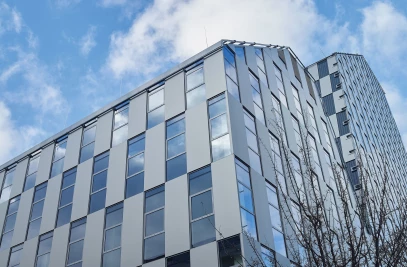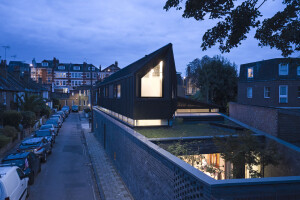The imposing silhouette of Grands Moulins de Pantin (the large Pantin windmills) dominates the East Paris cityscape between Porte de la Villette and Porte de Pantin. Their neo-regional architecture with its three towers is a powerful symbol of the industrial past of the Ourcq Canal. This heritage will be protected when the entire sited is modernized to develop a service-sector complex over 50,000 sq m in area. Contemporary buildings will be used to rebuild the site's North and East sides, forming a coherent whole with the silos and the old windmill. This project is part of the quarter's large-scale redevelopment plan. The link between the past and modernity will be retained in each section of the site, not through an obsessive desire for preservation but in order to retain each historical period of the place.
The great Pantin windmills are one of the last symbols of the extensive industrial activity in the city's past, and remain in the forefront of the imagination of Parisians. Their silhouette, which took shape in the 20th century, rises on the horizon and stands as an emblem transcending the initial purpose of the buildings. Beyond preserving the most characteristic built sections forming the site's urban silhouette, our work is centred around two principles: - horizontally projecting the new buildings with a view to preserving and enhancing the two main existing parts of the buildings; - projecting in cross section and elevation these same new buildings (stratification and composition principle) according to their height and to how imposing they seem in the setting. The preserved parts include the “grand moulin” (the great windmill, which comprises the flour store, the silos and the old boiler room, at the eastern boundary of the plot) and the “petit moulin” (the small windmill, the central building, which was originally a windmill). In addition to these two building shells there are the two existing footbridges, and the slender transporter bridge that protrudes towards the canal. The reconstructed complex is articulated around a main axis, designed as a wide indoor street linking Rue du Débarcadère and the small windmill. There is a central concourse level with the latter, a veritable unitary area lined with the façades of the new buildings and with the renovated ones of the old buildings, providing foot access to all the entrance halls and car parks.
Its design echoes the significant architectonic elements of the original (rails, paving stones, etc.) associated with new compositional elements (vegetation, the downward slope and relief of the ground, street furniture, etc.), thus forming wooded and protected pedestrian areas. (In the same spirit a central delivery yard on level G-1 is formed so as not to detract from the pedestrian areas between the buildings.) The new buildings, which are relatively deep, are organized around concourses arranged either as interior covered atriums or as open outdoor patios. Situated either side of the indoor street, their upper sections are reached by two slender and fully glazed walkways. Each of the concourses gives the working areas their character and forms a compositional link with all the offices and buildings. Brick is evidently the material that now characterizes the complex. We have strived to show it off in the preserved buildings and use it for the newly-built parts, transposed in a contemporary finish. In the old buildings, the piers are renovated and form aesthetically plain pillars recalling the initial composition. The apron walls and bay windows are finished with metal and glass panels. In the new buildings, the proportions of the in-fills and the bay windows are reversed. The façades are mostly glazed and highlighted at ground level by opaque band courses covered with terracotta panels. They are punctuated by alternating modular frames and opening sections standing out from the fixed sections. The boiler room, which was one of the site's important industrial features, now preserved and showcased at the heart of this office complex, is one of the emblematic features epitomizing the site's industrial past. This boiler room, which used to generate electricity for the entire site, is more than a utility. It sits imposingly at the heart of a building designed around its original function, which we wanted to preserve. Indeed we felt that the quality of the space around this utility was fully transposable and capable of going through the ages while adapting to other uses. In this characteristic place we have thus constructed one of the project's showcase areas: the large atrium.




































